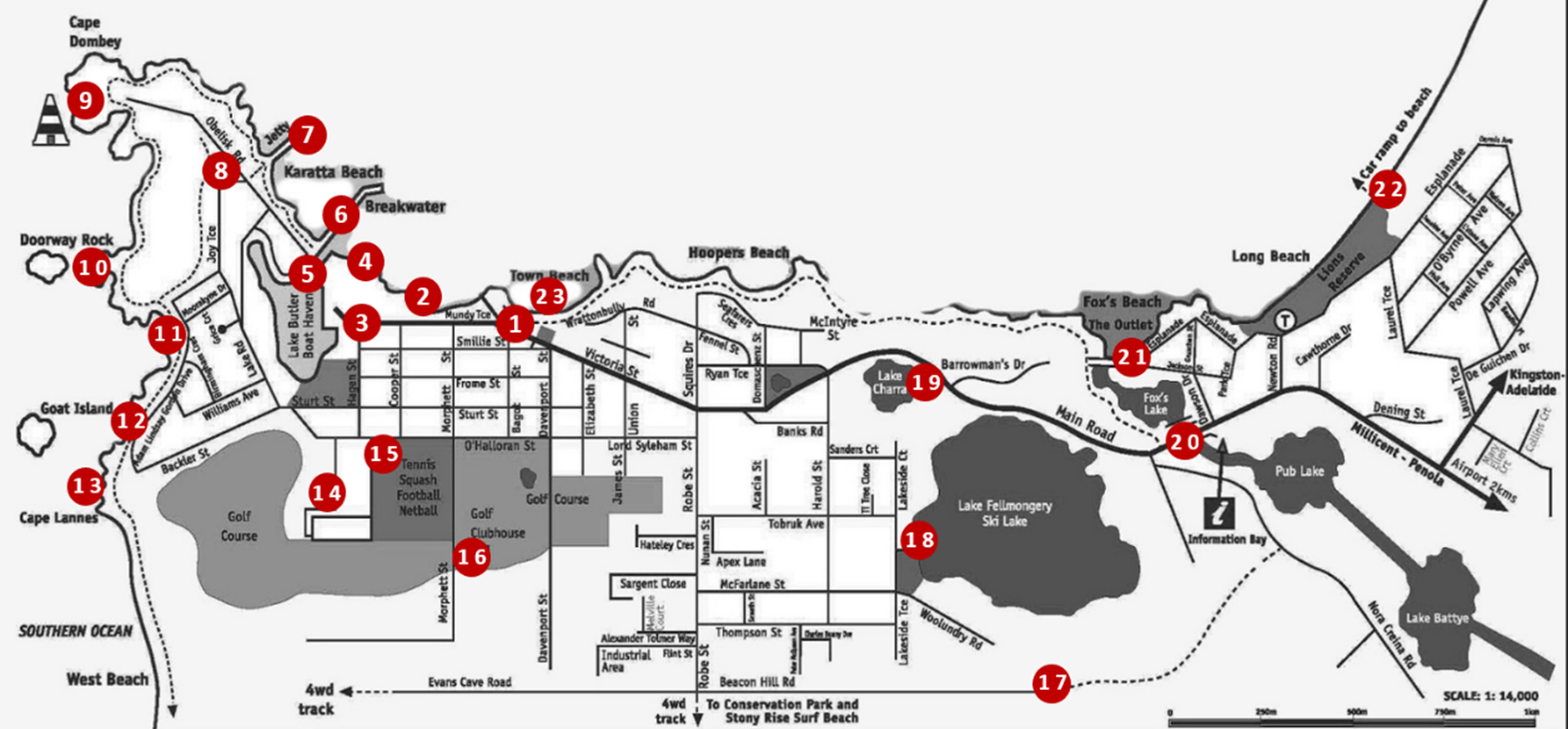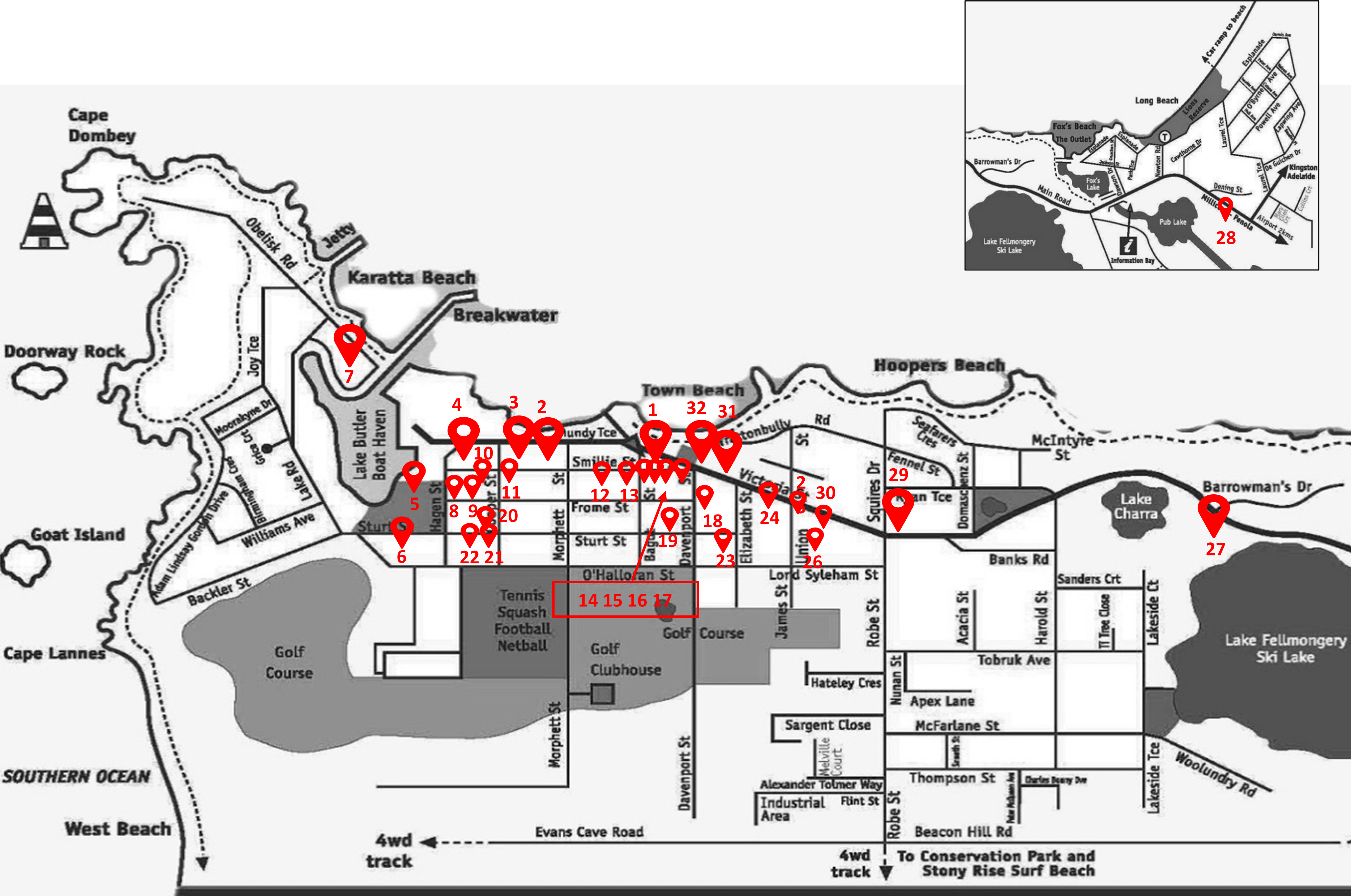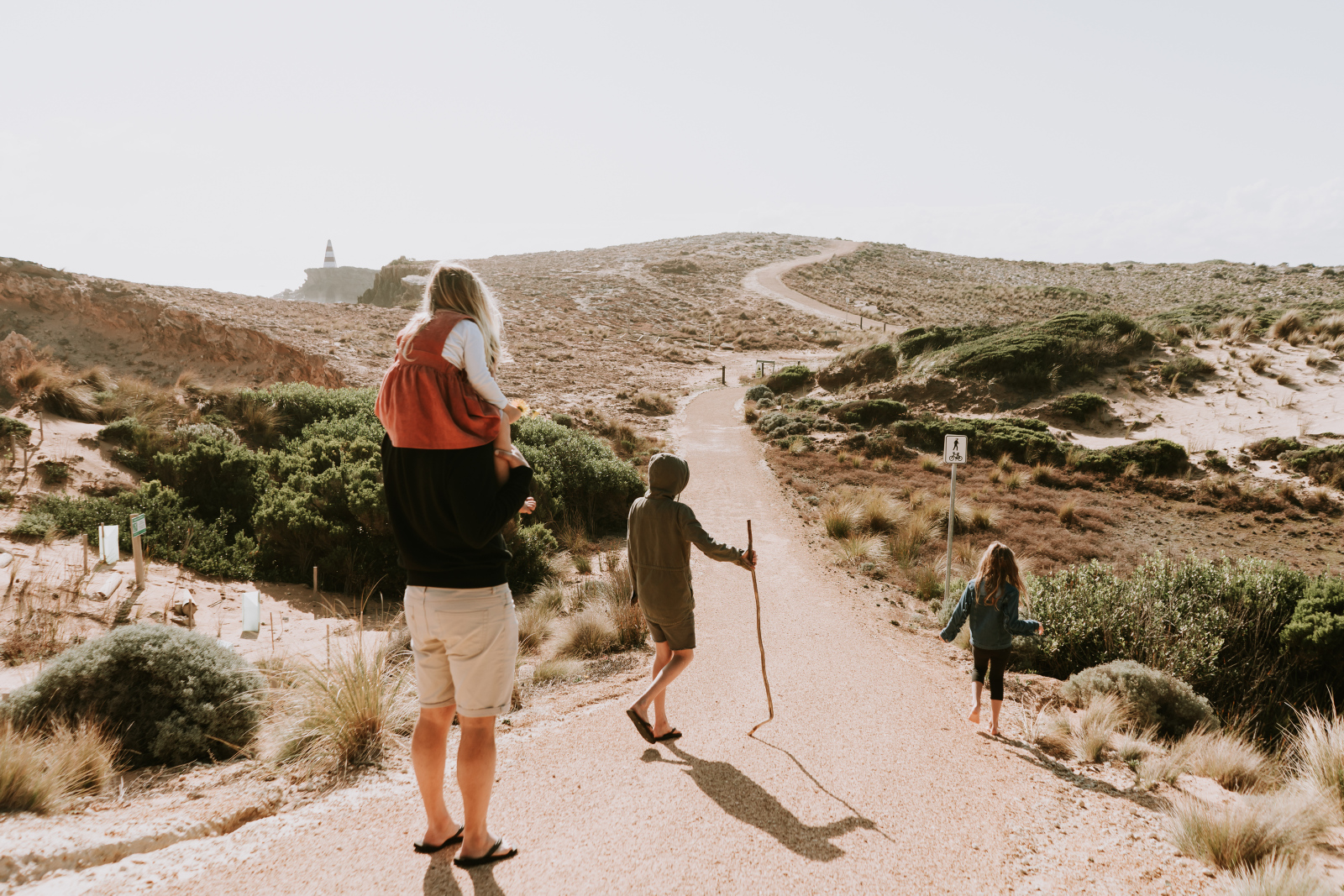The Obelisk stands proudly on the point of Cape Dombey. A local builder erected the 40-foot Obelisk in 1855 for $460 to act as a landmark for shipping & to contain rocket fired lifesaving equipment for stricken ships. The structure was originally white, but Captains found it difficult to differentiate it from Long Beach’s white sand hills. In 1862 it was repainted in alternate red & white bands. On a clear day, it can be seen from 20km away. Eventually tidal erosion will result in the Obelisk collapsing into the sea. *Park at the Old Goal Ruins and walk to view the Obelisk.
Long Beach is a safe family beach with gentle surf & is quite unique as it is one of the few beaches where you are able to drive your car onto the sand with over 12kms of pristine coastline. A unique part of Robe’s heritage.
The Outlet is where the lakes drain to the sea, this area is popular for waterbirds including pelicans, ibis and egrets. A great place for exploring.
Little Dip Conservation Park is an incredible natural playground for visitors wanting to go four-wheel-driving, fishing, bushwalking, camping and mountain bike riding. There are several lakes located throughout the park, each with their own unique character. The main lakes to visit are Lake Eliza, Big Dip Lake and the Fresh water Lake. There are also areas around the lakes which provide a haven for the birdwatchers.
Lake Butler Marina is the home of our crayfishing fleet & recreational boats. Lake Butler is a natural lake that was once closed to the sea. Fishermen used to moor their boats out in the bay during fishing season, and then drag them across the sand hills to moor in Lake Butler during the winter weather. In 1964, a 2m deep channel was dug to allow the fishing boats safe haven all year round. A fisherman’s memorial was built to honour the fishermen lost at sea.
Lake Fellmongery (Ski Lake) This large freshwater lake was given its industrial sounding name in 1853 when a fellmongery was established there to wash wool salvaged from a wrecked ship in Guichen Bay, the barque Duilius.
Royal Circus & Customs House The flagstaff was erected when Governor Frederick Holt Robe & Surveyor Thomas Burr took the first theodolite bearings for the town in 1846. The Matthew Flinders Memorial Seat commemorates the first English survey of the southern Australian coast by Captain Matthew Flinders in 1802. From here you can see Baudin Rocks named by Flinders after Captain Nicolas Baudin who led the French naval expedition which carried out the first survey of the South East Coast and Guichen Bay. The Cannon is reputed to be from the barque “Koning Willem II” wrecked in 1857.
Soldier’s Memorial First World War memorial and German naval mine which was found planted offshore and towed to Long Beach for deactivation in 1941.
Robe Lighthouse was built in 1972 to replace the Cape Jaffa Lighthouse and is fully automatic and unmanned.
Doorway Rock with its “doorway” created by the constant crashing of waves on the Limestone.
Robe Jetty is Robe’s 4th jetty and 3rd Government jetty.
The Old Gaol was built about 15 years after settlement in 1860 to house prisoners who had formerly been sent to Adelaide for trial. There were a number of escapes where prisoners assaulted guards and on one occasion, picked their way through the gaol walls. The walls were later reinforced with boilerplates from the Admella ship wreck.
Beacon Hill Lookout Tower The rebuilding of the Robe Lookout Tower at Beacon Hill took place as part of the Robe “150” Celebrations in 1996. The old wooden structure was removed and replaced by a circular paddock stone tower offering panoramic views of Robe. It was also used as a navigational aid for fishermen and was formerly called “One Tree Hill”.
The Chinese Memorial Remembers the 17,000 Chinese who landed at Robe between 1857 and 1863 on the lure of the Victorian goldfields. Here is the seawall and jetty site –3 jetties were built between 1842 and 1866 and “Pai Fang” Welcoming Gate.
BEACHES
Long Beach is a safe family beach with gentle surf and is quite unique as it is one of the few beaches where you are able to drive your car onto the sand. A unique part of Robe’s heritage. Great spot for swimming and surfing. Larger surf is usually from 3rd ramp onwards.
Town Beach is a safe family beach and this is where VacSwim swimming lessons take place each summer. Explore Girl and Boy Rock (or Butchers Rock) to the west or take a swim out to the pontoon.
There is a Beach Wheelchair available for hire (free of charge) from the Robe Library & Visitor Information Centre for use at Town Beach. This needs to be pre-booked and paperwork signed before use. Call 08 8768 2465 for more information.
Hoopers Beach is a safe family beach which is generally calm. There are rocky reef sections at each end of the beach. Great for swimming, snorkeling, kayaking or stand up paddle boarding.
Karatta Beach is home to the Robe Yacht Club. It is a safe family beach, and a great beach to sail from.
Fox’s Beach is a safe family beach with rocky reef sections.
West Beach walk over the dunes to experience the back boggy beaches. Not safe to swim here!
The Outlet is where the Drain L lakes system drain into the sea, this area is popular for waterbirds including pelicans, ibis and egrets, and great for exploring.
Little Dip Conservation Park Beaches showcase the beautiful, rugged coastline of the Limestone Coast and is lined by coastal sand dunes. Four-wheel drive access only to most of these beaches. Great spots for diving and snorkeling.
Wrights Bay Beach is an unearthed treasure of the region. The beach begins north of the Wrights Bay Caravan Park, car parking is available, it is recommended that experienced four-wheel drivers only access the beach by vehicle.
Stony Rise is an exposed beach and reef break that has consistent surf year-round.
LAKES
Lake Fellmongery (Ski Lake) This large freshwater lake was given its industrial sounding name in 1853 when a fellmongery was established there to wash wool salvaged from a wrecked ship in Guichen Bay, the barque Duilius. A great place for water skiing.
Drain L Lakes (Lake Battye, Lake Nunan, Pub Lake & Fox’s Lake (Park of the Drain L Lakes system) is one of the many man-made drains that crisscross the South East and earlier this century converted the area from swamps to fertile farming land. It links the small lakes which are popular bream fishing spots. A great place for fishing and non-motorised water sports such as kayaking, windsurfing and stand up paddle boarding.
Lake Charra is a breeding spot for local black ducks.
FISHING
There are many different places to go fishing in Robe, whether it be from the beach, jetty, marina or from a boat. A few of the fishing spots around Robe are:
- Lake Butler Marina and the channel
- Robe Jetty
- Breakwater
- Long Beach – past 3rd ramp is great for surf fishing
- West Beach
- Drain L Lakes system (Lake Battye, Lake Nunan, Pub Lake & Fox’s Lake)
- Jumbo’s Landing
- Use the Boat Ramp (4 lane boat ramp) to go fishing from your boat. Permits can be purchased from the Council Office, the Robe Library & Visitor Information Centre or for the ticket machine at the Boat Ramp.
Jenny Mathews Playground
Has a great playground for the kids and is connected to Mahalia Coffee's back gate for those needing a coffee or milkshake while at the playground.
There is a BBQ, shaded picnic benches and public toilets located here.
The Community Garden is also at this location.
Jumbo’s Landing
A great spot for fishing, non-motorised water sports or a picnic with the family.
There is a BBQ and public toilets located here.
Lion’s reserve (Long Beach)
A large open grassed area, with Long Beach accessible just over the sand dunes.
There is a large rotunda here with BBQ facilities, public toilets and a large playground.
Lipson Park
A large grassed area, great for a picnic or to let you dog off the lead for a run. Dogs are allowed off-leash at Lipson Park year-round.
There is a BBQ and public toilets located here.
Ski Lake
A great place for water skiing or a picinic with the family.
There is a boat ramp, BBQ and public toilets located here.
Information Bay
A great spot for a picnic on the edge of Pub Lake with a BBQ located here.
There are so many things to do while visiting Robe...
We have so many great places for eating, drinking and shopping.
You can visit wineries, cellar doors, breweries, a dairy and even a camel farm.
Explore the beautiful art galleries.
Go swimming, surfing, snorkeling, water skiing, fishing, four-wheel driving, walking, mountain bike riding, or head to the skate park.
You can play a round of golf, play social bowls, or go for a hit of tennis.
Book yourself a joy flight to check out how stunning Robe looks from above.
Admire the the many heritage listed buildings in Robe
We even have a cinema if you are looking for a little down time.
If you are looking for more ideas, be sure to contact the helpful staff at the Robe Visitor Information Centre - 08 8768 2465
SCENIC TRAIL
- Soldier’s Memorial | Cnr Smillie Street and Victoria Street: First World War memorial and German naval mine which was found planted offshore & towed to Long Beach for deactivation in 1941.
- Norfolk Pine Trees | Mundy Terrace: along Robe’s famous foreshore, the trees were planted to honour Robe citizens who served in World War I.
- Royal Circus & Customs House | Royal Circus: The Flagstaff was erected when Governor Frederick Holt Robe & Surveyor Thomas Burr took the first theodolite bearings for the town in 1846. The Matthew Flinders Memorial Seat commemorates the first English survey of the southern Australian coast by Captain Matthew Flinders in 1802. From here you can see Baudin Rocks named by Flinders after Captain Nicolas Baudin who led the French naval expedition which carried out the first survey of the South East Coast & Guichen Bay. The Cannon is reputed to be from the barque “Koning Willem II” wrecked in 1857.
- The Chinese Memorial | Mundy Terrace: Remembers the 17,000 Chinese who landed at Robe between 1857 and 1863 on the lure of the Victorian goldfields. See here the seawall and jetty site –3 jetties were built between 1842 and 1866 & “Pai Fang” Welcoming Gate.
- Lake Butler Marina | Lipson Terrace: is the home of our crayfishing fleet & recreational boats. Lake Butler is a natural lake that was once closed to the sea. Fishermen used to moor their boats out in the bay during fishing season, and then drag them across the sand hills to moor in Lake Butler during the winter weather. In 1964, a 2m deep channel was dug to allow the fishing boats safe haven all year round. A fisherman’s memorial was built to honour the fishermen lost at sea.
- The Breakwater | end of Karatta Road: built in 1964 from Kingston Granite. Adjacent is Karatta Beach & Robe Yacht Club.
- Robe Jetty | off Obelisk Road: is Robe’s 4th jetty & 3rd Government jetty.
- The Old Gaol | Obelisk Road: was built about 15 years after settlement in 1860 to house prisoners who had formerly been sent to Adelaide for trial. There were a number of escapes where prisoners assaulted guards & on one occasion, picked their way through the gaol walls. The walls were later reinforced with boilerplates from the Admella ship wreck.
- The Obelisk stands proudly on the point of Cape Dombey. A local builder erected the 40-foot Obelisk in 1855 for $460 to act as a landmark for shipping & to contain rocket fired lifesaving equipment for stricken ships. The structure was originally white, but Captains found it difficult to differentiate it from Long Beach’s white sand hills. In 1862 it was repainted in alternate red & white bands. On a clear day, it can be seen from 20km away. Eventually tidal erosion will result in the Obelisk collapsing into the sea. *Park at Old Goal and walk to view the Obelisk.
- Doorway Rock | Adam Lindsay Gordon Drive: with its “doorway” created by the constant crashing of waves on the Limestone.
- Factory Bay | Adam Lindsay Gordon Drive: was originally the site of a canning factory that used to can snipe and rabbits. After the World Wars it was used as Robe’s rubbish dump before people had an awareness of protecting the environment. Hotel green & brown bottles were dumped here & washed back into the cove. The area was also known as Glass Beach from the polished sea glass.
- Robe Lighthouse | Adam Lindsay Gordon Drive: was built in 1972 to replace the Cape Jaffa Lighthouse and is fully automatic and unmanned.
- West Beach Lookout & West Beach | Adam Lindsay Gordon Drive: walk over the dunes to experience the back boggy beaches. No swimming please!
- The Old Cemetery | O’Halloran Street: was built in 1857 as the original cemetery area. The site was first selected in 1849.
- Robe Football Oval | O’Halloran Street: local football, netball, squash & tennis.
- Robe Golf Course | Morphett Street: new 18 hole course was opened in November 2019.
- Beacon Hill Lookout Tower | Beacon Hill Road: The rebuilding of the Robe Lookout Tower at Beacon Hill took place as part of the Robe “150” Celebrations in 1996. The old wooden structure was removed and replaced by a circular paddock stone tower offering panoramic views of Robe. It was also used as a navigational aid for fishermen and was formerly called “One Tree Hill”.
- Lake Fellmongery (Ski Lake) | Lakeside Terrace: This large freshwater lake was given its industrial sounding name in 1853 when a fellmongery was established there to wash wool salvaged from a wrecked ship in Guichen Bay, the barque Duilius.
- Lake Charra | Main Road: is a breeding spot for local black ducks.
- Drain L Reserve | Main Road: Drain L is one of the many man-made drains that crisscross the South East and earlier this century converted the area from swamps to fertile farming land. It links the small lakes which are popular bream fishing spots.
- The Outlet | Cnr Esplanade & Dawson Drive: is where the lakes drain to the sea, this area is popular for waterbirds including pelicans, ibis & egrets, & great for exploring.
- Long Beach | Esplanade: is a safe family beach with gentle surf & is quite unique as it is one of the few beaches where you are able to drive your car onto the sand. A unique part of Robe’s heritage.
- Town Beach | Mundy Terrace: is also a safe family beach & is where VacSwim swimming lessons take place. Explore Girl and Boy Rock (or Butchers Rock) to the west.

HERITAGE TRAIL
- Robe Institute | Smillie Street: was built in 1868 & during Robe’s heyday was the heart & soul of the community as a popular venue for many social occasions, including a Picture Theatre. Additions were built to The Institute in 1983.
- Robe Hotel | 4 Mundy Terrace: has been continuously licensed since it was opened as Robe’s first hotel, ‘The Bonnie Owl’ in 1847.
- Old Telegraph Station | 2 Mundy Terrace: where the first telegram was received in Robe on 20 July 1858 via the South Australian magnetic Telegraph.
- Customs House | Royal Circus: is a roundabout encircling a small sand hill & was the focal point for the original planned government town of Robe. It was also used by bullock drays throughout Robe’s days as a busy port. The Customs House was built in 1863 & used for 25 years as a Customs House & office of Harbour Master & Receiver of Wrecks for the SE coast as far as the Victorian border. It now houses the Maritime Museum.
- Our Lady Star of the Sea Chapel | 2 Hagen Street: was built in 1858, one of the first 3 Catholic Churches to be built in S.A.
- Moorakyne House (Green Gables) | 4-6 Sturt Street: was built in 1853 by George Ormerod, whose company conducted all of the export trade & most of the import trade during Robe’s boom period as a port.
- Karatta House | 7 Karatta Road: is a magnificent “holiday home” built in 1863 by a wealthy grazier, and used by the then Governor of South Australia Sir James Ferguson as his holiday home from 1869-1873.
- Robe House | 1A Hagen Street: was the first substantial stone house in Robe and was built in 1847 as the official residence of the Government Resident in the South East.
- Old Police Stables | Lot 301 Frome Street: built in 1864, the Robe Police Stables form part of the former Courthouse complex. Robe had 3 mounted policeman responsible for a huge geographical area both for police duties and delivery of mail. Following the decline of Robe as an international trading port, the Stables we converted to a garage and horses were replaced by police cars. This site was also where 26 mounted red coats kept their horses during the “Chinese Invasion”.
- Courthouse | 8 Smillie Street: where the Government Resident was magistrate.
- Ormerod Cottages | 10 Smillie Street: were built to house Ormerod’s staff in 4 self-contained dwellings. Ormerod Cottages later housed an accountant, private school teacher, doctor, lawyer & the assistant gaolkeeper during boom times.
- Bank House | 24 Smillie Street: was designed by architect Edmund Wright & built around 1857 possibly by George Ormerod on a speculative basis for later sale to the Bank of South Australia in 1860 for £3,752.
- Campbell Cottages | 26 Smillie Street: were first built as a single storied building dwelling for a Scottish apothecary with the upper storey and shop being added when 1/2 the building was leased to the National Bank.
- Criterion Hotel (now Cornerstone Cottage & Criterion Cottages) | 28 Smillie Street: was built by George Lord in the 1850’s to service the needs of the upper class & business clientele.
- George Lord’s Horseshoe Forge | 30 Smillie Street: was built in the 1850s.
- Davison’s Shop | 32 Smillie Street: was built in 1855.
- Greymasts | 38 Smillie Street: was originally built in 1853 by George Ormerod to store wool salvaged from a shipwreck. Greymasts later helped accommodate 80 girls sent to work on pastoral properties from Mosquito Plains to Mt Gambier. Robe’s renowned historian Kathleen Bermingham also lived at Greymasts.
- School in Rotten Row | 8 Davenport Street: was a private school for girls built in the 1860’s.
- Granny Bank’s Cottage | 15 Sturt Street: built in several stages with the oldest section dating from 1846. It was first rented to government personnel, then occupied by George Ormerod while Moorakyne was being constructed. Arthur & Sarah (Granny) Banks bought the cottage in 1855 and lived there until 1900.
- St Peter’s Anglican Church | 24 Sturt Street: was built 1859 by the local gentry.
- Free Presbyterian Kirk | 22 Sturt Street: Robe’s first church and a small and unassuming building built in 1858.
- Patsy Ryan’s Cottage | 10 Elizabeth Street: was once occupied by one of Robe’s identities Patsy Ryan, an Irish migrant.
- Attic House | 18 Victoria Street: was built in 1869 as a tailor’s shop with a high, distinctive upper storey. W.T. McLean made suits and riding silks for the famous poet & horseman Adam Lindsay Gordon & other gentlemen.
- William Savage Cottage | 22 Victoria Street: were constructed by Robe’s main stonemason & builder William Savage in the 1850’s.
- Blind Barlowe’s Tom Pepper’s Cottage | 11 Union Street: formerly occupied by this poet, basket weaver & “Good Templar”.
- Lakeside Manor | 22 Main Road: (next to Lakeside Caravan Park) was built for George Affleck who transformed from a labourer into a “gentleman” on inheriting an English Baronetcy in the late 1880’s. His work included washing wool in Lake Fellmongery. *not shown on below map
- Bush Inn | 82 Main Road: This inn was licensed between 1861 & 1871 being one of several roadside inns that served teamsters who bought wool bales into Robe piled high on bullock & horse drays during the busiest years of the port of Robe. This Cobb & Co stop was also licensed as The Newton Arms. *not shown on below map
- The Lodge | 1 Main Road: was built in 1850 as a Butcher Shop and residence.
- Bermingham’s Cottage | 28 Victoria Street: was built after 1858 on an allotment of the new “Village of Syleham”.
- Wilson’s Saddlery | 5 Victoria Street: William Wilson handcrafted first-class saddles that were much prized by the horsemen of the district.
- Caledonian Inn | 1 Victoria Street: was built in 1859 by a Scotsman Peter McQueen. Several upstairs rooms were fitted with scrolled teak doors salvaged from the shipwreck, “Koenig Willem II”.

Discover these trails on a walk, run or ride.
More details on these trails can be found at: www.walkingsa.org.au/walk/find-a-place-to-walk/robe-walking-trails-and-loop-path/

© Robe, Limestone Coast, photo by Jayme Chapman
MOUNTAIN BIKE TRAILS
The Coastal Trails are popular trails to be explored by Mountain Bike in Robe, however for the serious MTB riders, head out to the Beach Hill trails which the Robe Mountain Bike Association have curated.
Details of these trails can be found here: www.trailforks.com/region/robe--beacon-hill-32293/
LITTLE DIP CONSERVATION PARK TRAILS
Fresh Water Lake Walk
www.walkingsa.org.au/walk/find-a-place-to-walk/fresh-water-lake-walk-little-dip-conservation-park/
Big Dip Lake Walk
www.walkingsa.org.au/walk/find-a-place-to-walk/lake-eliza-hike-little-dip-conservation-park/
